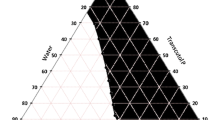Abstract
This study was conducted to develop an emulgel formulation of chlorphenesin (CHL) using 2 types of gelling agents: hydroxypropylmethyl cellulose (HPMC) and Carbopol 934. The influence of the type of the gelling agent and the concentration of both the oil phase and emulsifying agent on the drug release from the prepared emulgels was investigated using a 23 factorial design. The prepared emulgels were evaluated for their physical appearance, rheological behavior, drug release, antifungal activity, and stability. Commercially available CHL topical powder was used for comparison. All the prepared emulgels showed acceptable physical properties concerning color, homogeneity, consistency, spreadability, and pH value. They also exhibited higher drug release and antifungal activity than the CHL powder. It was found that the emulsifying agent concentration had the most pronounced effect on the drug release from the emulgels followed by the oil phase concentration and finally the type of the gelling agent. The drug release from all the emulgels was found to follow diffusion-controlled mechanism. Rheological studies revealed that the CHL emulgels exhibited a shear-thinning behavior with thixotropy. Stability studies showed that the physical appearance, rheological properties, drug release, and antifungal activity in all the prepared emulgels remained unchanged upon storage for 3 months. As a general conclusion, it was suggested that the CHL emulgel formulation prepared with HPMC with the oil phase concentration in its low level and emulsifying agent concentration in its high level was the formula of choice since it showed the highest drug release and antifungal activity.
Similar content being viewed by others
References
Sweetman SC.Martindale: The Complete Drug Reference. 33rd ed. London, UK: The Pharmaceutical Press; 2002:381.
The Pharmaceutical Codex. 11th ed. London, UK: The Pharmaceutical Press; 1979:181.
Eceleston GM. Emulsions. In: Swarbrick J, Boylan JC, eds.Encyclopedia of Pharmaceutical Technology. Vol 5. New York, NY: Marcel Dekker Inc; 1992:137–188.
Rieger MM. Emulsions. In: Lachman L, Lieberman HA, Kanig JL, eds.The Theory and Practice of Industrial Pharmacy. 3rd ed. Philadelphia, PA: Lea and Febiger, 1986:502–533.
Klich CM. Jels and Jellies. In: Swarbrick J, Boylan JC, eds.Encyclopedia of Pharmaceutical Technology. Vol 6. New York, NY: Marcel Dekker Inc; 1992:415–439.
Abd El-Bary A, Shalaby S, Abd El-Aal S. Formulation and stability of chloramphenicol gel and emulgel.Bull Fac Pharm. 2001;39:89–99.
Zhang XL, Zhao R, Qian W. Preparation of an emulgel for treatment of aphthous ulcer on the basis of carbomers.Chin Pharm J. 1995;30:417–418.
Hamza YE, Molokhia AM, Soliman H, Ahmed FH, Soliman NA. Formulation and evaluation of topical preparations containing phenol and local vesicants.Az J Pharm Sci. 2002;29:412–432.
Mohamed MI, Mortada ND. Development of a thermoreversible gel for controlled-release ocular delivery of diclofenac sodium.Az J Pharm Sci. 1999;24:133–139.
Hugo WB, Russell AD.Pharmaceutical Microbiology. Oxford, UK: Blackwell Scientific Publications; 1977:190.
Clearly GW. Transdermal controlled release systems. In: Langer RS, Wise DS, eds.Medical Applications of Controlled Release. Vol 1. Boca Raton, FL: CRC Press; 1984:204–251.
Lucero MJ, Vigo J, Leon MJ. A study of shear and compression deformations on hydrophilic gels of tretinoin.Int J Pharm. 1994;106:125–133.
Abd El-Bary A, Tayel S, Amin SY, Osman A. Bioavailability of salbutamol sulphate from different suppository formulations.Egypt J Pharm Sci. 1992;33:1031–1043.
Bolton S.Pharmaceutical Statistics. 3rd ed. New York, NY: Marcel Dekker Inc; 1997:326–354.
Higuchi WI. Analysis of data on the medicament release from ointments.J Pharm Sci. 1962;51:802–804.
Author information
Authors and Affiliations
Corresponding author
Additional information
Published: October 11, 2004.
Rights and permissions
About this article
Cite this article
Mohamed, M.I. Optimization of chlorphenesin emulgel formulation. AAPS J 6, 26 (2004). https://doi.org/10.1208/aapsj060326
Received:
Accepted:
Published:
DOI: https://doi.org/10.1208/aapsj060326




